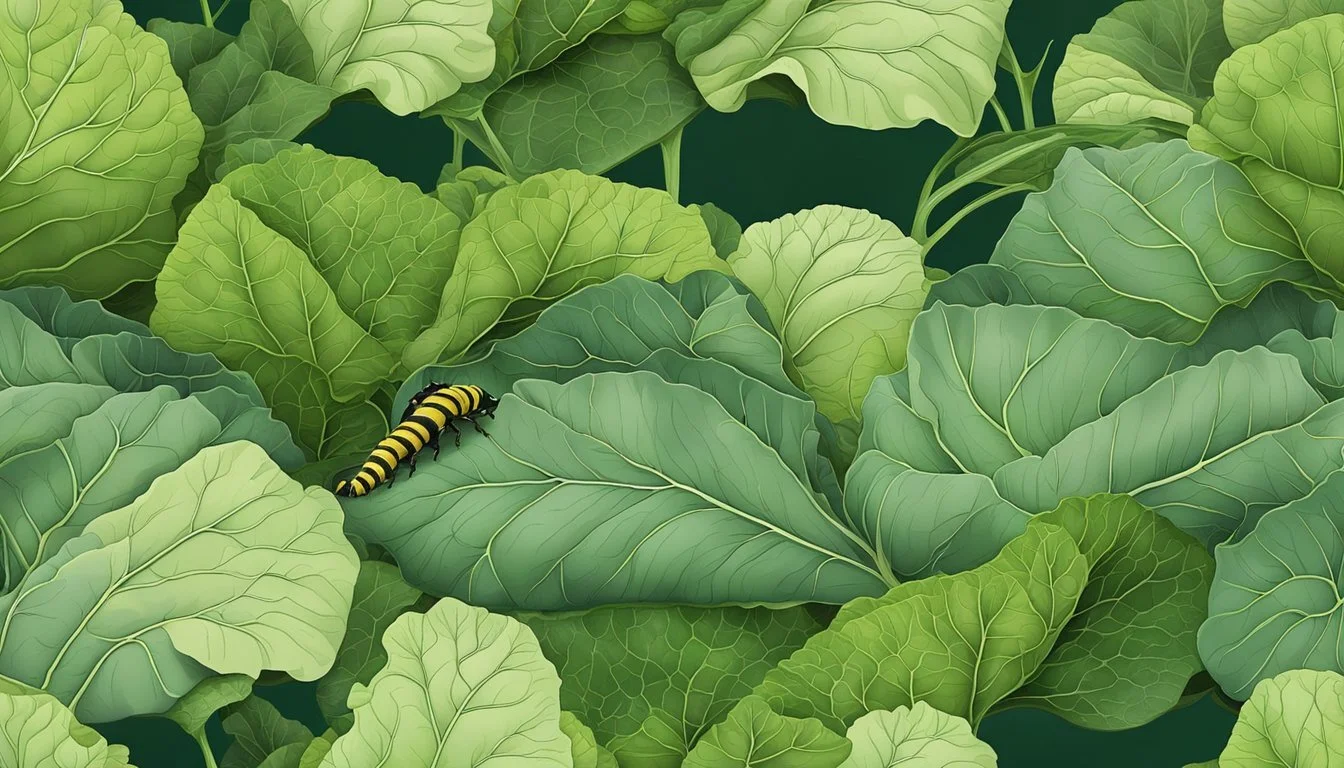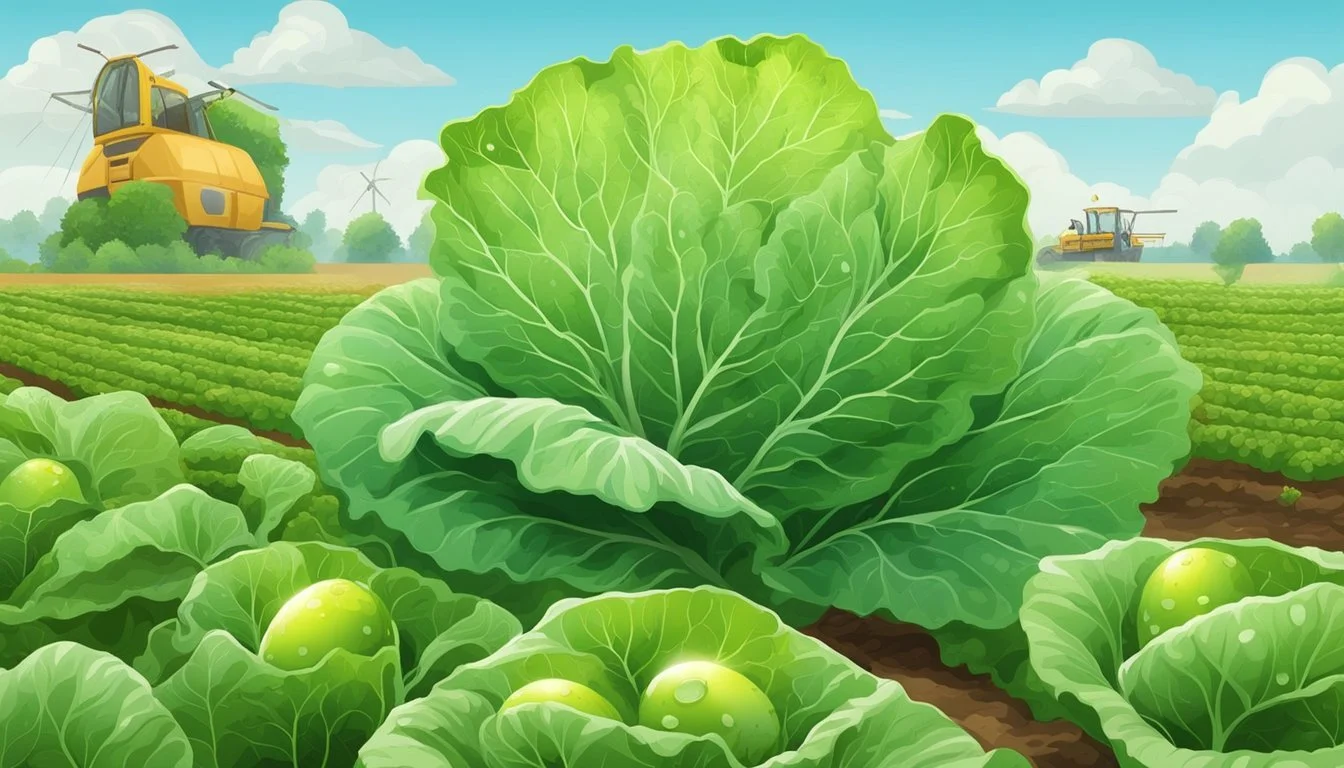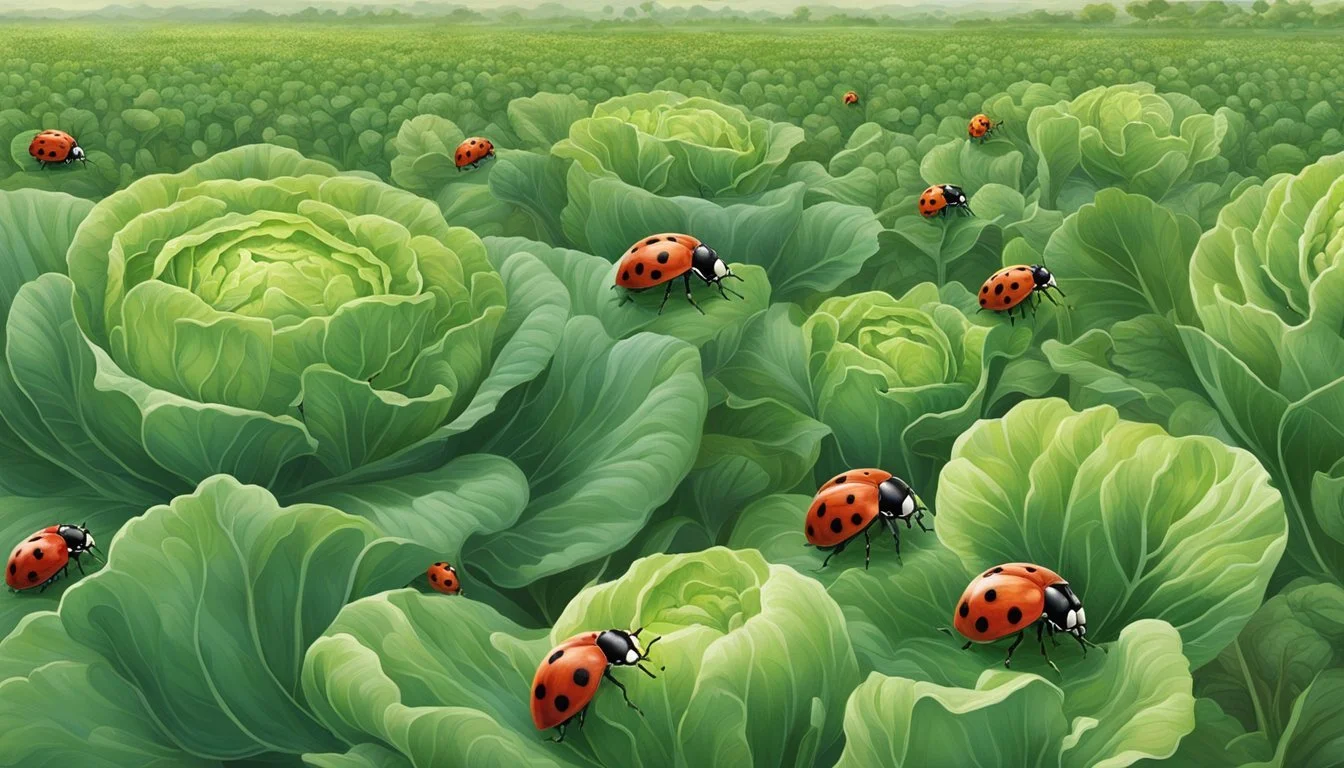Protecting Crops from Cabbage Looper
Effective Management Strategies
Cabbage loopers are a common pest that poses a significant threat to a variety of crops, especially members of the Brassica family such as cabbage, broccoli, and kale. Their voracious appetite for foliage can lead to substantial damage, potentially impacting crop yields. These caterpillars are easily identifiable by their distinctive looping movement as they inch along plants, propelled by their pairs of prolegs.
Effective management of cabbage loopers involves early detection and an integrated approach. Gardeners and farmers must stay vigilant, routinely inspecting their plants for the telltale signs of looper activity—irregular holes chewed in leaves and the presence of small, green caterpillars. By combining mechanical, cultural, and biological control methods, one can protect their crops from the damage these pests cause.
For robust defense against cabbage loopers, many advocate for the use of floating row covers to prevent adult moths from laying eggs on the plants. Meanwhile, fostering an environment that supports natural predators of the cabbage looper can help manage the population. In cases where an infestation has taken hold, some may opt for organic insecticides; however, careful consideration is advised to minimize harm to beneficial insects.
Understanding the Cabbage Looper
The cabbage looper is a notorious pest in agricultural communities, primarily attacking plants in the cabbage family. They are easily identified by their distinct inchworm-like movement and the damage they inflict on crops.
Characteristics
The cabbage looper caterpillar is a pale green larva with a white stripe along each side and several narrow lines down its back. Adults are moths with a wingspan of about 1.5 inches, typically gray or brown with a distinct silver mark on each forewing. Gardeners often detect their presence by the "frass," or droppings, left on the foliage.
Life Cycle
Cabbage loopers have a life cycle with multiple stages: from eggs laid directly on the plant leaves to larvae that feed voraciously before they pupate. The pupation stage occurs within a thin, silk cocoon where the larvae transform into adult moths. Extended periods of warm weather can lead to multiple generations in a single growing season.
Identification
These pests can be identified in their larval stage as inchworms that arch their bodies as they move, measuring approximately 1.5 inches in length at maturity. The eggs of the cabbage looper are small, dome-shaped, and white, found on the underside of leaves. Proper identification is crucial for targeted pest control measures, such as the application of Bacillus thuringiensis, a biological control safe for use on food crops.
Cabbage Looper Habitat
The cabbage looper, a notable garden pest, prefers environments where host plants are abundant. They are resilient and adapt to a variety of climates but thrive mainly in gardens and agricultural areas with cole crops.
Common Host Plants
Cole Crops: Cabbage loopers have a special appetite for a group of plants known as cole crops, including cabbage, broccoli, cauliflower, and Brussels sprouts.
Leafy Greens: They also target leafy greens such as lettuce, spinach, and kale.
Other Vegetables: Their host range extends to beets, radishes, and even tomatoes.
Seasonal Behavior
Spring to Fall: Cabbage loopers are active from spring through fall. Their presence in gardens typically peaks when temperatures are warm and host plants are readily available.
Winter: In many regions, cabbage loopers can survive mild winters as pupae, reemerging as moths during the spring to lay eggs on new crops.
Signs of Infestation
Detecting a cabbage looper infestation early is crucial for protecting crops effectively. Recognizing the marks of damage and the presence of the pest itself are key indicators that inform appropriate control measures.
Visible Damage
One of the most apparent signs of a cabbage looper infestation is the visible damage on the leaves. These pests cause irregular holes as they chew through the foliage. As they continue to feed, they have the potential to defoliate a plant completely, leaving behind skeletonized leaves which can severely stunt plant growth and reduce crop yields.
Looper Presence
In addition to the damage, the presence of the cabbage looper itself is a telltale sign. Gardeners may notice small, green caterpillars on their crops. These caterpillars are identified by their distinctive "looping" movement. Another sign is the presence of frass (caterpillar droppings) on the leaves of infested plants, which further confirms an infestation.
Natural Predators and Biological Control
Employing natural predators and biological control methods is an effective strategy against the cabbage looper (Trichoplusia ni). Such measures leverage the looper’s natural enemies to reduce its population without resorting to chemical pesticides.
Beneficial Insects
Wasps: Trichogramma wasps play a crucial role as they lay their eggs inside cabbage looper eggs, preventing them from hatching.
Ladybugs: Known for their voracious appetite, ladybugs consume large numbers of cabbage loopers.
Spiders: These natural predators are often found patrolling plant leaves for prey, including various larval pests.
Predatory Beetles: These insects actively hunt the larval stage of the cabbage looper, helping to manage the pest population.
Parasitic Wasps: Apart from Trichogramma wasps, there are larger parasitic wasps that target and control looper larvae by parasitizing them.
Birds and Wildlife
Birds: Many avian species feed on cabbage loopers, providing a natural form of pest control from above. Their presence in the garden creates a biodiverse environment that helps in maintaining the ecological balance.
Chickens: When allowed to forage, chickens can significantly reduce pest populations, including cabbage loopers, by actively seeking them out and eating them.
Wildlife: Various wild animals and insects contribute to the biological control by preying on the cabbage looper, though their impact varies and may be less predictable than that of beneficial insects or domestic birds.
Cultural and Mechanical Control Methods
Cultural and mechanical control methods focus on preventing the Cabbage Looper from establishing and thriving in crop areas. These methods are proactive approaches that help protect crops without relying on chemical interventions.
Sanitation Practices
Sanitation is a crucial aspect of managing Cabbage Looper populations. Regular removal of plant debris from the field, especially after harvest, can significantly decrease the number of places where these pests can overwinter and lay eggs. Ensuring that the crop area is free from old crops and weeds limits the resources available for Cabbage Loopers.
Physical Barriers
Physical barriers such as floating row covers can provide effective control against Cabbage Loopers. These barriers prevent adult moths from laying eggs on the plants. When implemented correctly, row covers need to be sealed at the edges and kept in place throughout the susceptible periods of the crops. Properly secured, these covers block Cabbage Loopers without obstructing sunlight or rainfall.
Chemical and Organic Pesticide Options
When combatting cabbage loopers, gardeners have a range of chemical and organic pesticide options at their disposal. Effectiveness, environmental impact, and safety for non-target species should guide the choice between insecticides and organic treatments.
Approved Insecticides
Approved insecticides such as spinosad are known for their targeted action against pests like the cabbage looper while being safer for beneficial insects when used as directed. These substances are available as concentrates or ready-to-use insecticide sprays. It's essential to follow the instructions on the label to avoid toxic effects on non-target organisms.
Organic Treatments
For those seeking alternatives to traditional insecticides, neem oil and pyrethrin-based products offer a more nature-friendly approach. Neem oil acts as an antifeedant and growth regulator, deterring cabbage looper activity. Pyrethrin extracts, derived from Chrysanthemum species, quickly incapacitate loopers yet degrade rapidly in sunlight, minimizing their environmental footprint. Another favored option is Bacillus thuringiensis (B.t.), which is a microbial insecticide that is specific to caterpillars and harmless to other wildlife. Organic pesticides can be equally effective when applied with strategic timing and proper concentration.
Integrated Pest Management Strategies
In tackling the issue of the cabbage looper, a moth in its larval stage that threatens a variety of crops, integrated pest management (IPM) approaches focus on combining various control methods to minimize damage. These strategies aim to manage pest populations effectively while reducing reliance on insecticides.
Pest Monitoring
Pest monitoring is critical in IPM to detect the presence of cabbage loopers early. Farmers use pheromone traps to track moth activity, as adult cabbage loopers are attracted to the specific scent. Regularly checking these traps provides a clear indication of the pest's presence and population density in the field.
Threshold Levels
Determining threshold levels is essential for deciding when to take action against cabbage loopers. Control methods are implemented only when the pest density exceeds a level that could potentially cause economic damage to the crops. This threshold varies depending on the crop stage and the extent of infestation. Implementing control tactics too early or late could be ineffective or lead to unnecessary expenses, which no commission on agricultural best practices would endorse.
Prevention and Long-Term Management
Effective prevention and long-term management strategies for cabbage looper control are crucial for maintaining healthy crops. These measures minimize the need for chemical interventions and foster a more resilient agricultural ecosystem.
Crop Rotation and Diversity
Crop rotation is a fundamental preventative approach. By planting different species of crops in subsequent seasons, one can disrupt the life cycle of cabbage loopers, which reduces the likelihood of infestation across multiple generations. For instance, rotating non-brassica crops after a season of brassicas can help to prevent the buildup of damaging cabbage looper populations.
It is also beneficial to increase crop diversity within the garden. The introduction of a variety of plants not only creates habitat for natural predators of the cabbage looper but also can reduce the overall appeal of the area to the pest. A diverse plant ecosystem in gardens may serve as a buffer to protect core crops from being targeted.
Season Extension
Practices of season extension such as utilizing row covers can shield transplants and young crops during critical growth periods, especially in winter or early spring. By creating barriers, gardeners can deter adult cabbage loopers from laying eggs on the plants. This physical method acts as a first line of defense against infestations and is particularly advantageous as it avoids the employment of pesticides.
Row covers should be applied with care to ensure proper ventilation and sunlight penetration, essential factors for the healthy growth of plants. Moreover, these covers must be securely anchored to prevent cabbage loopers and other pests from accessing the plants.
Frequently Asked Questions
In tackling the challenge of cabbage loopers, understanding detection, management, and prevention is critical for protecting crops effectively. Below are answers to commonly asked questions that can guide farmers and gardeners in their efforts to combat this pervasive pest.
How can I identify and manage cabbage looper infestation in crops?
Cabbage loopers are identified by their distinctive looping motion as they move. They are light green caterpillars with a white stripe along each side and several narrow lines down the back. To manage an infestation, frequent inspection of crops is essential. Removing caterpillars by hand and destroying them helps reduce their population. Incorporating insecticidal soaps or oils can be effective at managing these pests on small garden plants.
What are some effective biological control methods for cabbage loopers?
Biological control methods include introducing natural predators like parasitic wasps and birds into the crop area. Another option is applying beneficial nematodes that target and kill the larvae. Planting flowering herbs can attract these natural enemies to the garden.
What chemical pesticides are recommended for controlling cabbage loopers?
For severe infestations, chemical control might be necessary. Chemicals such as synthetic pyrethroids can be used sparingly and as directed to minimize damage to beneficial insects. Always follow label instructions and use recommended chemical pesticides designed for cabbage loopers.
How can Bacillus thuringiensis (Bt) be used to control cabbage worms?
Bacillus thuringiensis, commonly known as Bt, is a naturally occurring soil bacterium that produces toxins harmful to certain insects including cabbage loopers. Bt-based insecticides, available in powder or liquid form, can be sprayed on plants. When ingested by the larvae, it disrupts their digestive system, causing them to stop feeding and eventually die.
What cultural practices can help prevent cabbage looper damage in the garden?
Cultural practices for prevention include using rowing covers to exclude moths from laying eggs, rotating crops, and maintaining a tidy garden to minimize hiding spots. Additionally, choosing cabbage looper-resistant plant varieties and timing plantings to avoid peak moth activity can reduce the likelihood of infestation.
Can you describe the life cycle of the cabbage looper and how it affects pest management strategies?
Cabbage loopers have a life cycle that includes egg, larval, pupal, and adult stages. Eggs are laid on the underside of leaves, which hatch into larva that feed voraciously on plants. Understanding their life cycle is paramount to effectively timing control measures. For instance, interventions are most effective when targeted at the larval stage, before they cause significant damage and mature into egg-laying adults.




